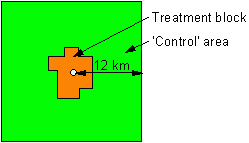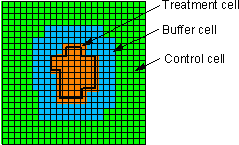 Methods for Evaluating Treatment Success
Methods for Evaluating Treatment Success Methods for Evaluating Treatment Success
Methods for Evaluating Treatment Success
Successful treatment does not necessarily mean that the colony has been eradicated. If the initial population numbers were high, then several successful treatments may be needed to complete the eradication.
The reduction of moth captures in the treatment block should be compared with moth capture change in the 'control' area around it. The control area is set within the 24 x 24 km area as shown in the picture below.

If the length or width of the treatment area is >12 km, then the control area is enlarged so that its height and width are at least twice as large as the treatment block. Then a 0.5-km grid is set over the treatment block and control area. Cells that intersect with the treatment block are considered 'treatment cells'. Neighboring cells (at a distance of 1.5 km) are 'buffer cells' and the other cells are 'control cells'. Buffer cells are not used in the analysis. If another treatment block appears in the control area, then the cells that intersect with that block are discarded (they are not considered as control cells).

Moth counts in pheromone traps are interpolated in the 0.5-km grid of cells using median indicator kriging with subsequent E-type estimation (Deutsch and Journel 1992). Then these interpolated values are averaged separately among treatment cells and control cells.
Index of treatment success is estimated using the equation:
Criterion C is used to evaluate how close we are to the goal of bringing moth counts in the treatment block to the background level. It is estimated as a ratio of average moth captures in treatment cells and control cells, i.e.,
If C = 1, then moth counts in the treatment block are the same as in the control area outside, i.e., the goal of colony management is reached. If C > 1, then additional treatments may be necessary in the following year. If the criterion C is high, it does not necessarily mean that treatment was not successful, but it indicates that additional treatments are needed. Colonies with a high initial density may require multiple successful treatments to bring the criterion C to 1. Each successful treatment decreases the value of C, and when C becomes equal to or less than 1, the goal is reached and treatment is not applied in the following year. Thus, criterion C should be viewed as an indicator of a long-term success in managing a colony.
For more information, please contact Patrick Tobin or Andy Roberts
Maintained By Jiang Wu